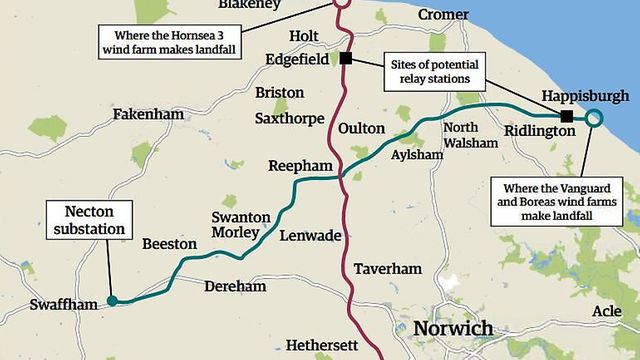Eighty five Norfolk Parish Councils came together to plea to the Energy Secretary to refuse planning consent for what would be the largest offshore wind farm in the world.
They are not against the principle of Offshore energy, in fact they are very supportive of it, but their concern focuses on the disruption that will be caused to large tracts of Norfolk.
Connecting the turbines to the National Grid will require 60 kilometres of underground cables dug into a trenche up to 80 metres wide
This will run from Happisburgh on the coast to a new substation at Necton.
And Ridlington is right in it's path.

the Norfolk Parish Movement for an Offshore Transmission Network (OTN)
Calls on the government to move beyond "stone-age" technology which necessitates miles of on-shore trenches and cables and instead connect the wind farms off the coast, something which the wind farm firms say is not yet possible and would take years to implement.
I would recommend reading the whole EDP article at
If, after reading this article,
you can see the benefits of
our Parish Council
supporting our fellow 85 Council
then you can approach them at
BTW – Bacton and Walcott Parish Council did not add their signature either
8 Responses
I’ve never read such poppycock in quite some time. What is proposed is excellent for the country, yet YOU are whinging over a bit of disruption? By any chance is it the older generation voicing their opinion??
No one is objecting to the project we just believe that there are better methods, i.e. in Denmark, to harness the energy offshore without slicing and dicing the countryside.
I don’t think your ageist comment warrants a reply.
I’m really sorry but it really isn’t that easy to change this. The technology will take years to develop and build and there are also numerous legislative changes required which is also likely to take an awfully long time. Should we keep kicking this particular issue down the road then we will start seeing the impact of global warming on our coastal communities and end up having this debate with the water lapping around our feet – or maybe worse than that in places such as Gt Yarmouth, Lowestoft and coastal North Norfolk.
Yes I appreciate that no one wants this in their back yard but it really is necessary to do this and to do it at speed to reduce our dependency on fossil fuels.
Happy to discuss it from my point of view just to provide some balance.
It’s not a case of I don’t want tis on my patch Simon it’s seeking to find a better way as they have done in Denmark.
I am a believer if we got a man on the moon in 1969 and secured workable vaccines in less than a year – the anything is achievable.
Your comments are much appreciated.
Will the end result be comparable to the huge scars that (don’t) remain after the four primary backbone gas network pipelines were installed from the Shell and Prerenco receiving terminals at Bacton?
Just how does the alternative avoid the single point of failure inherent in a single main feeder?
How attractive a target would a non-redundant critical piece of national infrastructure be, for terrorist organisations?
Would we need a significantly increased armed MOD police presence to protect this?
There has been comment about the unknown physiological effects of a cable carrying “1.8GW”. Can that comment be re-stated in a way that actually makes technical sense and avoids just bandying a Big Sounding Number? The line voltage is 400kV, which equates to a current of ca. 4500A. Neither of these are particularly remarkable. A large V8 engine starter may draw up to about 200Amps. Now, a magnetic field falls off according to the square of the distance. The battery / starter wiring in a car may be 1m from the occupants. The magnetic field around a single conductor carrying 4500A will be about the same for someone 5m from the cable, as those passengers would have experienced while starting their car.
Around a pair of conductors, however, the field will be significantly less as the fields round the paired cables will cancel.
Similar arguments apply to the 400kV line voltage if compared to – say – the ignition system voltages in a car or the EHT voltage in a CRT TV tube.
You’re welcome to check my sums and correct me if I’m wrong.
John, I am going to have to defer to you on all the scientific points as
I lack any knowledge on those topics.
I remember the Bacton/Great Yarmouth episode and you are correct – there
are no scars.
But I don’t think that is an argument to continue with the planed
implementation.
Firstly this effects a much greater portion of land area and, more
importantly, other collection sources are coming on stream.
As we develop more offshore sources we really need some offshore
collection method else the Eastern Counties will pay the price.
Sorry to disagree with such a poor argument on my part.
Stay safe, John
Pauline Porters Parish Council is a law unto herself.
When really it’s established in law for you…